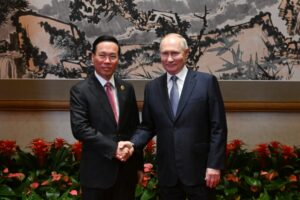- The Russian-led Eurasian intergovernmental military alliance is losing steam as its members are being ignored.
- Russia’s war in Ukraine is being responsible for the weakening of the alliance’s performance in the Central Asian region.
- Moscow’s loss of regional power could strengthen the United States and China in the region.
The Collective Security Treaty Organization, better known by the acronym CSTO, is in decay and one of the main reasons for this collapse is the war orchestrated by Russian President Vladimir Putin in Ukraine, which began in February 2022.
The alliance, which was supposed to be a rival to the North Atlantic Treaty Organization (NATO), is suffering from the potential evasion of its members and, in September of the same year, faced a request from Armenia to the United States in the conflict. Nagorno-Karabakh, after Yerevan was ignored by Russia.
After Armenian contact with the then American rivals, the fragility of the CSTO became even more evident and alarmed the other members, countries of the former Soviet Union, which already have their confidence in Putin shaken. Which raises questions like: Will the CSTO have the same outcome as the late Warsaw Pact?

What is CSTO?
The Collective Security Treaty Organization (CSTO) is an intergovernmental Eurasian military alliance led by Russia and which brings together countries of the former Soviet Union such as: Belarus, Armenia, Kazakhstan, Kyrgyzstan and Tajikistan, in addition to Russia itself.
The alliance was made official in its current form in 2002 and, in opposition to, but similar to, the North Atlantic Treaty (NATO), the CSTO establishes that an aggression against a signatory would be perceived as an aggression against all, and its members are prohibited from join other military alliances.
How the CSTO should rival NATO
The CSTO inevitably harks back to its predecessor Warsaw Pact. The official name of the pact was the Treaty of Friendship, Cooperation and Mutual Assistance, being signed in Warsaw, capital of Poland, in May 1955.
It was a military cooperation agreement signed by the nations of the socialist bloc in Eastern Europe and was the result of the context in which it was inserted. The alliance is considered a reaction by the Soviet Union to actions taken by the United States in Western Europe.
With the creation of the pact, the Soviets reinforced their military presence in the participating countries, but important cooperation clauses were created, such as mutual defense, as well as in the current Collective Security Treaty.
Then, the Warsaw Pact came to an end due to the crisis in the Soviet Union, with the Berlin Wall being torn down and the end of the Cold War. Already the CSTO sees its existence threatened, again, due to the chaos in which Russia has caused and is inserted in Ukraine and the possible repetition of the Russian threat to the sovereignty of member countries.
How the CSTO abandoned Armenia in the conflict with Azerbaijan and benefited the United States
In September 2022, Azerbaijan launched attacks on Armenians inside Nagorno-Karabakh and allegedly directly attacked Armenian territory. The country then appealed to its CSTO allies to collaborate in its defense.
But the response from Russia and other CSTO members reinforced the Armenians’ lack of confidence in their neighbors. The organization that was supposed to send immediate help decided to send a fact-finding mission, but even before the mission arrived, the organization revealed that it would not send peacekeepers.
Azerbaijan, Armenia’s neighbor, is not part of the organization, but maintains good relations with all other alliance members. Therefore, Armenia already had doubts about the help of the allies.
Due to the lack of support, protesters took to the streets of Yerevan, demanding that the country withdraw from the Moscow-led CSTO. Protesters argue that the alliance has not done enough to protect Armenia and have called for the country to move closer to Western powers.
Many of the protesters say the United States of America and Europe are the country’s last hope amid the Nagorno-Karabakh conflict.
In view of the Armenian request for help, the US offered help and the visit of Nancy Pelosi, Speaker of the US House of Representatives and third in the line of succession, made clear the replacement of Russia by the US as an ally of Armenia, which reaffirms US influence in the region.
Pelosi confirmed the readiness of the United States to provide political and diplomatic support to Armenia. However, in order for the United States to provide Armenia with not only diplomatic and political support but also weapons, Armenia needs to withdraw from the CTO.
Other Former Soviet Republics That May Be Leaving the CSTO
Kazakhstan has been pulling away from Moscow since the start of Russia’s war against Ukraine. However, since the Russian invasion of Donbass 8 years ago, Astana has feared the possibility of scenarios similar to those of Ukraine happening in its northern territories on the border with Russia, which is inhabited by ethnic Russians.
Kyrgyzstan also appears to be a candidate to leave the organization. In October 2022, the country canceled the CSTO military exercise scheduled to be held on its territory in early October, without prior notice.
The exercises were scheduled from 10 to 14 October and were supposed to include military personnel from all six CSTO members, as well as five other states including Serbia, Syria and Uzbekistan, but no reason was given for the cancellation announced on 9 October 2022.
After Tajikistan President Emomali Rahmon’s attack on Putin at the Tashkent regional leaders summit in October 2022, it is entirely possible that this military alliance will be left with just two members: Belarus and Russia.
Why the weakening of the CSTO is important to the world power game
The weakening of the Collective Security Treaty Organization further undermines Russia’s sphere of influence, which is mostly the countries of the former Soviet Union.
This loss of regional power by Russia, consequently, could strengthen the United States in the region and foster the exact opposite of one of the objectives of the CSTO, which is to avoid a Western presence in the region.
Finally, one of the biggest consequences of the weakening of the CSTO and Russia is opening the door to other types of military alliances in Central Asia.
In addition to the Western powers – including other NATO members, alongside the US – it is possible that China will begin a military approach to these countries, in addition to the multiple economic agreements already in place between Beijing and Central Asian countries.
In this way, a weakening of the CSTO is yet another example of Russia’s loss of international influence as a power since its aggression against Ukraine and, consequently, a possible geopolitical victory for two other global powers, the United States and China. It’s Russia digging its own grave.














[…] will witness a further weakening of the power and influence of Russia and the countries of the CSTO – a NATO-like military alliance between several countries in Central Asia and Eurasia – which […]
[…] lack of Russian action and support promised for Armenia in the Nagorno-Karabakh conflict is giving way to rapprochement between the United States and […]
[…] Strategic Alliances: France seeks strategic alliances with Armenia, a country that was “abandoned” by Russia during the war with Azerbaijan. By strengthening ties with Armenia, France is effectively […]
[…] some Central Asian countries like Kazakhstan and Uzbekistan, which fear being the next targets of a new imperialist Russia following the invasion of Ukraine, […]